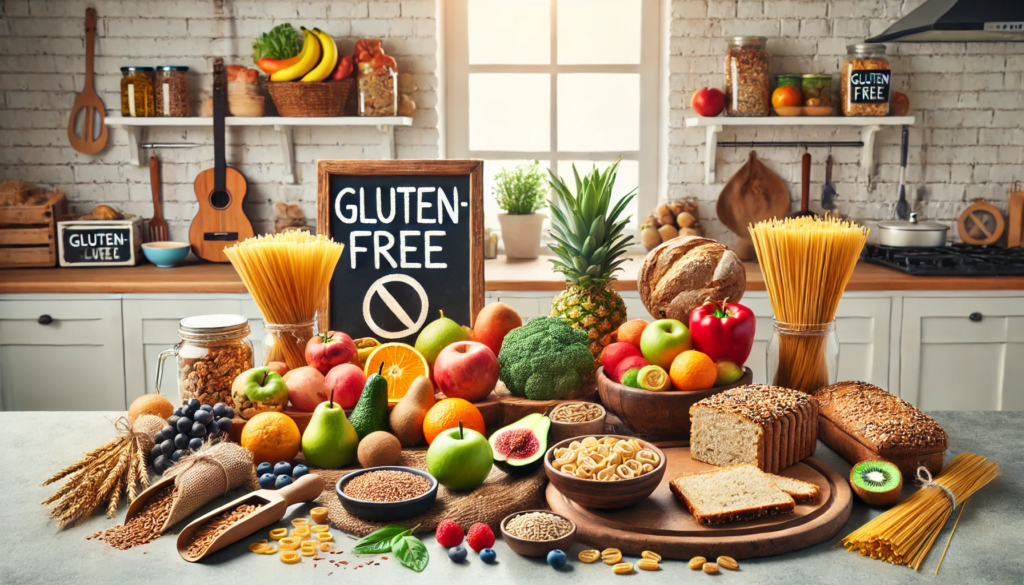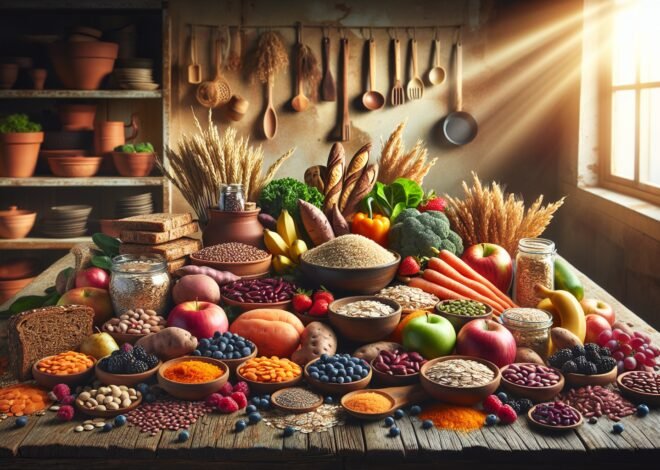
Top 20 Tips for Gluten-Free Living: A Complete Guide
Living gluten-free can be essential for those with celiac disease, gluten sensitivity, or a gluten allergy. It requires careful planning and awareness of what foods are safe to eat. Here are the top 20 tips to help you navigate a gluten-free lifestyle successfully while ensuring a balanced and nutritious diet.
1. Understand What Gluten Is
Gluten is a protein found in wheat, barley, rye, and their derivatives. It is commonly found in bread, pasta, cereals, and many processed foods. Understanding what gluten is and the foods that contain it is the first step toward a gluten-free lifestyle.
2. Learn to Read Food Labels
Reading labels is crucial for identifying hidden sources of gluten in packaged foods. Look for “gluten-free” labels or certifications, and be aware of ingredients like wheat, barley, malt, and rye. Cross-contamination is also a risk, so choose products from brands that follow strict gluten-free manufacturing processes.
3. Focus on Naturally Gluten-Free Foods
Many whole foods are naturally gluten-free, including fruits, vegetables, nuts, seeds, meat, fish, eggs, dairy, and gluten-free grains like quinoa, rice, and buckwheat. Base your diet on these nutrient-dense options for a balanced approach.
4. Stock Up on Gluten-Free Grains
Gluten-free grains include quinoa, rice, millet, buckwheat, sorghum, and amaranth. These grains provide important nutrients and fiber, making them great alternatives to wheat-based products. Incorporate these grains into meals as substitutes for pasta, bread, or other wheat products.
5. Find Gluten-Free Substitutes
There are many gluten-free substitutes for traditional foods, such as gluten-free bread, pasta, and baking flour blends. These products are often made from alternative flours like almond, coconut, or rice flour. Experiment with different brands to find the substitutes you like best.
6. Plan Ahead When Dining Out
When eating out, research restaurants that offer gluten-free menus or options. Call ahead to confirm that they can accommodate a gluten-free diet and ask about cross-contamination risks in the kitchen. Some restaurants are more knowledgeable about gluten-free protocols than others.
7. Prepare Gluten-Free Snacks
Keep gluten-free snacks on hand, such as nuts, seeds, gluten-free granola bars, or rice cakes. This helps you avoid gluten-containing snacks when you’re on the go. Pre-packaged snacks labeled “gluten-free” ensure you have a safe option when you’re in a rush.
8. Cook at Home More Often
Cooking at home gives you control over the ingredients used, ensuring that your meals are gluten-free. It also allows you to experiment with gluten-free recipes and enjoy a wider variety of foods. Use gluten-free cookbooks or online recipes for inspiration.
9. Avoid Cross-Contamination
Cross-contamination can occur when gluten-free foods come into contact with gluten-containing foods or surfaces. Use separate utensils, cutting boards, and toasters for gluten-free items. Store gluten-free foods away from other foods to prevent accidental contact.
10. Be Careful with Sauces and Condiments
Many sauces, condiments, and dressings contain gluten as a thickener or flavor enhancer. Check labels for hidden sources of gluten, or make your own gluten-free versions at home. Look for gluten-free certifications on store-bought products.
11. Choose Gluten-Free Beverages
Some beverages, such as beer, may contain gluten. Opt for gluten-free beers or ciders, and check labels on flavored drinks, teas, or coffees that may contain gluten additives. Wine and distilled spirits are generally gluten-free, but always verify the brand.
12. Invest in Gluten-Free Cookbooks
Gluten-free cookbooks can be a valuable resource, providing recipes and ideas for meals that accommodate your diet. They can also introduce you to alternative ingredients and cooking techniques that make gluten-free living easier and more enjoyable.
13. Learn About Gluten-Free Baking
Baking without gluten requires some adjustments. Invest in gluten-free flour blends and thickeners like xanthan gum or guar gum, which help mimic the texture of traditional baked goods. Experimenting with different gluten-free flours can yield delicious results.
14. Supplement Your Diet
If you are not getting enough fiber, iron, or B vitamins from your gluten-free diet, consider taking supplements. Some gluten-free grains are less fortified than traditional wheat products, so adding a multivitamin or specific supplements can help fill nutritional gaps.
15. Connect with the Gluten-Free Community
Join gluten-free forums, social media groups, or local meetups to share experiences, recipes, and tips. Connecting with others who follow a gluten-free lifestyle can provide support and helpful recommendations for managing the diet.
16. Watch for Hidden Gluten in Non-Food Products
Gluten can be present in non-food items such as medications, supplements, cosmetics, and toothpaste. Check the ingredients list for hidden sources of gluten or look for gluten-free labeling on these products to ensure safety.
17. Educate Family and Friends
Educating your family and friends about your gluten-free needs helps them understand the importance of avoiding gluten. This awareness can make social gatherings and shared meals safer and more enjoyable.
18. Be Aware of Gluten-Free Fads
While some people adopt a gluten-free diet as a trend, it is essential for those with celiac disease or gluten sensitivity. Focus on genuine gluten-free needs rather than following fads. A gluten-free diet may not provide health benefits to individuals without gluten intolerance.
19. Set Up a Gluten-Free Pantry
Organize your pantry to keep gluten-free foods separate from gluten-containing products. Label gluten-free items clearly, and consider using separate containers for flours and grains to avoid contamination.
20. Stay Informed About New Products
The gluten-free market is continuously expanding, with new products and innovations. Stay informed about new gluten-free foods, recipes, and tips to make your gluten-free journey easier and more enjoyable.
Conclusion
Living gluten-free can be manageable and even enjoyable with the right strategies and resources. By following these top 20 tips, you can navigate a gluten-free lifestyle confidently while maintaining a nutritious and balanced diet. Focus on naturally gluten-free foods, educate yourself about hidden sources of gluten, and explore new recipes and products to make gluten-free living a positive experience.
FAQ: Gluten-Free Living
1. What is a gluten-free diet?
A gluten-free diet excludes all foods that contain gluten, a protein found in wheat, barley, rye, and their derivatives. It’s essential for people with celiac disease, non-celiac gluten sensitivity, or a wheat allergy to avoid gluten in order to prevent symptoms and improve health.
2. Who should follow a gluten-free diet?
A gluten-free diet is necessary for individuals with celiac disease, gluten sensitivity, or a wheat allergy. For those with celiac disease, consuming gluten can damage the small intestine and lead to malabsorption of nutrients. People with non-celiac gluten sensitivity may also experience symptoms like bloating, headaches, and fatigue when they consume gluten.
3. Is a gluten-free diet healthier for everyone?
Not necessarily. While a gluten-free diet is crucial for people with gluten-related disorders, there is no evidence that it provides health benefits for people without these conditions. In fact, some gluten-free products are highly processed and may lack essential nutrients found in whole grains.
4. What foods are naturally gluten-free?
Many whole foods are naturally gluten-free, including:
- Fruits and vegetables
- Meat, poultry, and fish (unprocessed)
- Eggs
- Dairy products (unprocessed)
- Nuts and seeds
- Gluten-free grains (quinoa, rice, buckwheat, millet)
5. What are common symptoms of gluten intolerance?
Symptoms of gluten intolerance may include:
- Bloating and gas
- Abdominal pain
- Diarrhea or constipation
- Headaches or migraines
- Fatigue
- Joint pain
- Skin rashes If you suspect gluten intolerance, consult a healthcare professional for proper testing and diagnosis.
6. How can I avoid cross-contamination?
To avoid cross-contamination:
- Use separate cookware, utensils, and toasters for gluten-free foods.
- Store gluten-free foods in separate containers or areas.
- Clean surfaces thoroughly before preparing gluten-free meals.
- Check for hidden sources of gluten in sauces, condiments, and packaged foods.











